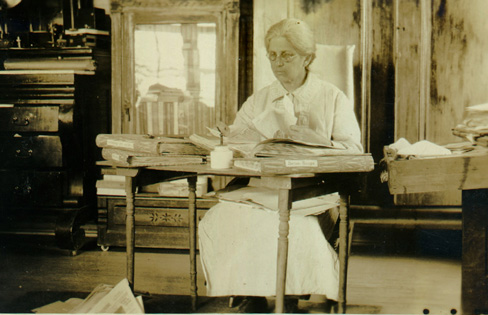Cammie Garrett Henry
Cammie Henry played a central role in Louisiana's artistic and literary communities, as both a patron of the arts and preservationist.

Courtesy of Northwestern State University.
Black and white reproduction of a photograph of Cammie Henry seated at a desk.
Carmelite “Cammie” Henry played a central role in Louisiana’s artistic and literary communities, as both a patron of the arts and preservationist. Along with her husband, she was the owner of Melrose Plantation, a pecan and cotton plantation in Natchitoches. Once the home of Louis Metoyer, a prominent member of the Cane River Creole community, Melrose had fallen into despair, and she spent much of her life meticulously restoring and maintaining it. Following the unexpected death of her husband in 1918, she opened her home to a variety of writers, artists, and intellectuals, including Lyle Saxon and Alberta Kinsey. She also revived interest in local crafts and built an extensive collection of Louisiana history resources.
Born January 14, 1871, on Scattery Plantation in Ascension Parish, Carmelite Garrett was the daughter of Stephen Garrett and Leudivine Carmelite Erwin Garrett. After growing up on a large sugar plantation where her father was an overseer, she completed her formal education at the Louisiana Normal College in Natchitoches (now Northwestern State University), where she earned a diploma and teaching certificate. She also met the younger generation of Natchitoches elite, including John Hampton Henry, Sr., whom she married in 1894. Five years later, the family moved to the rapidly deteriorating Melrose Plantation big house, which John Henry had inherited from his father. Unoccupied since before the Civil War, the big house was in desperate need of repair and restoration—a task she embraced with great gusto.
Cammie Henry spent a lifetime restoring and preserving the plantation house, the outbuildings, and surrounding grounds at Melrose. While raising seven sons and one daughter, she endured the isolation of rural life, dirt roads that were impassable during the rains, summer months of tropical heat and humidity, and almost year-round onslaught of bugs, particularly mosquitoes, and snakes. With the assistance of her friend, naturalist Caroline Dormon, Henry renovated the plantation gardens. Determined to return Melrose to its glory days, she filled the plantation with local antiques, some of which were originally owned by the Metoyers. To learn about the community’s history, she collected books and assembled numerous scrapbooks, filled with information about the plantation and local history.
When John Henry died from a sudden and unexpected massive cerebral hemorrhage in 1918, Cammie Henry expanded her interest in the arts. A strong supporter of the Natchitoches Art Colony—established by her friends Irma DeBlieux Sompayrac and Gladys Breazeale—Cammie Henry opened her home to the students and instructors, enabling them to paint the Melrose landscape. She also become interested in traditional weaving techniques and bookbinding, often sharing her skills with others in the community.
Having converted some of the plantation buildings into studio spaces, Henry invited artists from across the nation to visit, work, and even live at Melrose. In addition to Lyle Saxon and Alberta Kinsey, her visitors included Harnett Kane, Rachel Field, and Ada Jack Carver. Saxon, perhaps her most frequent visitor, wrote most of his novel, Children of Strangers, while in residence. Because of Henry’s efforts, Melrose became an important artistic and literary community during the Southern Renaissance—a period of intense literary production by southern writers between World War I and the end of World War II.
In the 1930s, Henry invited Francois Mignon to help her organize some of her collection and assist with the many guests. Mignon, along with many of her other guests, helped Henry amass and organize a collection of more than seven thousand books and manuscripts, and 256 scrapbooks filled with photographs, clippings, and other ephemera. While at Melrose, Mignon also mentored a black domestic servant who demonstrated an interest in painting, Clementine Hunter. Hunter went on to become one of Louisiana’s best known artists.
Cammie Henry died on Melrose Plantation on November 17, 1948. Her collection of materials on Louisiana history and culture now form the basis of the Melrose Collection at the Cammie G. Henry Research Collection at Northwestern State University. Though one of her sons, J. D. Henry, ran the plantation until his death in 1969, the land and most of the home’s furnishing were eventually sold. The main house, many of its outbuildings, and six acres of land were donated to the Association of Natchitoches Women for the Preservation of Historic Natchitoches (now the Association for the Preservation of Historic Natchitoches). Melrose Plantation became a National Historic Landmark in 1974 and is currently open to the public.
